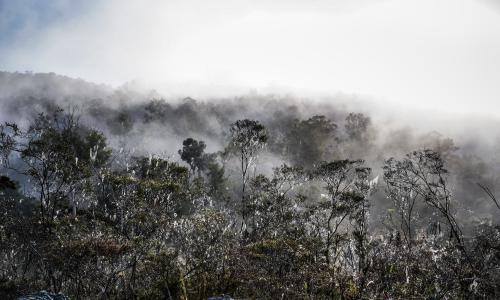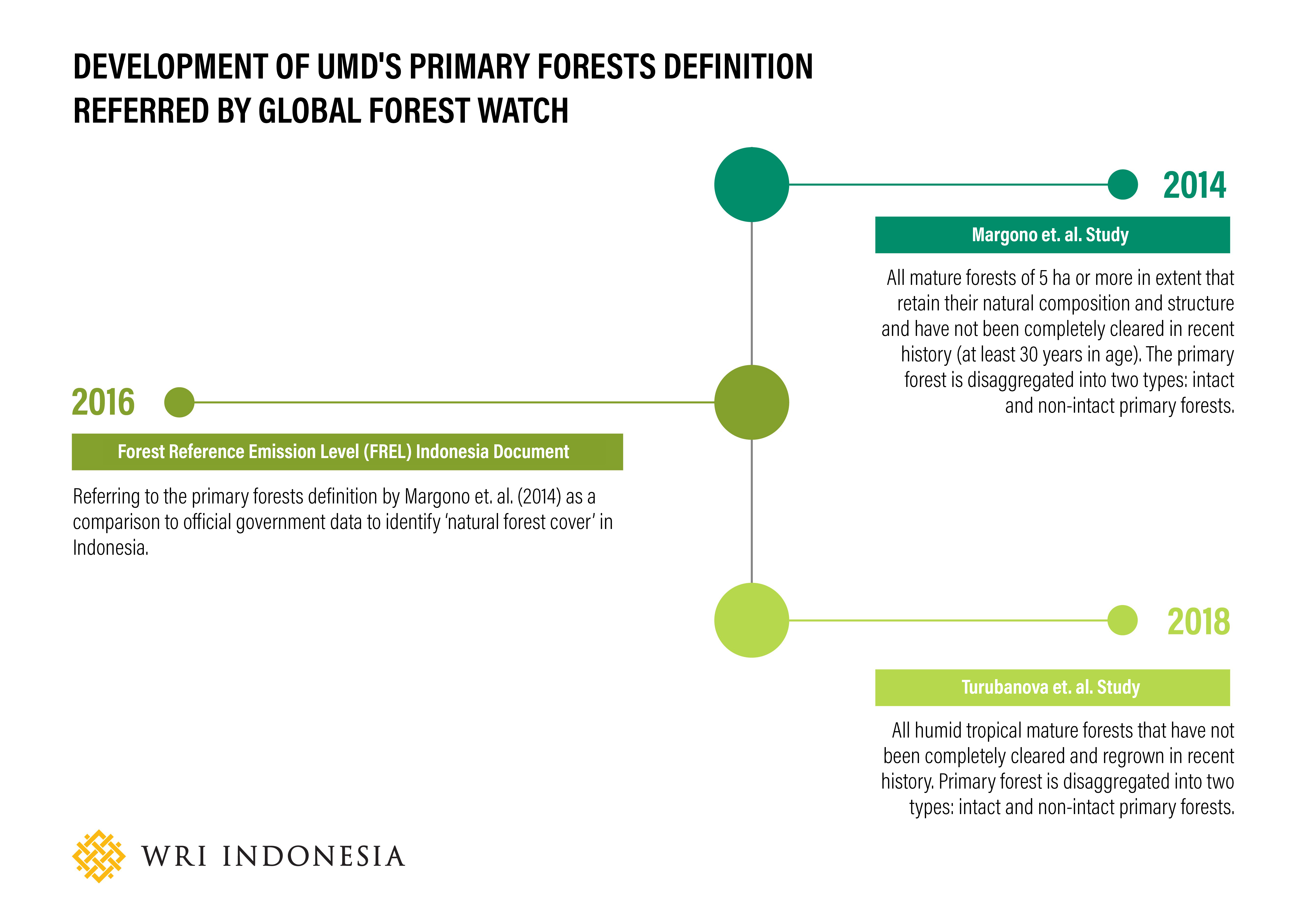
Global Forest Watch Technical Blog: Definition and Methodology of 2019 Forest Loss Data in Indonesia
In 2019, the world lost 3.8 million hectares of tropical humid primary forest, or the equivalent of losing a football pitch of forest every six seconds for the entire year. The data was released by the University of Maryland (UMD) and published on the Global Forest Watch.
Since its launch in 2014, GFW’s main mission has been to promote the transparency of data and scientific information on the world’s forests in order to preserve them and stop deforestation. Understanding that each country has different methods and definitions, GFW adopts methods and definitions that allow users to calculate and compare tree cover loss and forest cover loss across multiple countries in the world.
Therefore, the method and definition used are universal, and based on scientific research principles. GFW used data and methods based on research by the UMD. Independent and open data platforms such as GFW and Forest Atlas serve to complement the various data currently available. The transparency of data and information has paved the way for stakeholders from governments, private sector, and the general public to engage in discussions and generate better information, which in turn is expected to help inform better forest management policies.
In principle, each scientific research in forestry may develop its own definition of what constitutes a forest and subsequently apply different methods for calculating deforestation. Each method certainly has its advantages and disadvantages, such as in terms of defining forest types, deforestation, mapping units, monitoring periods, and so on. Furthermore, different methods produce different results. These different methodologies are common in academic discussions, and they continue to create space for discussions and enable continuous improvement of methods.
How does the University of Maryland produce this data? And how is this data different compared to other data sources? These questions are explored in this post.
Different Definitions of Primary Forest
Definition of Primary Forest from UMD
GFW uses the definition of humid tropical primary forest based on scientific journals by Margono et al. (2014) and Turubanova et al. (2018). According to both publications, primary forest is defined as all humid tropical mature forests that have not been completely cleared and regrown in recent history. In these studies, primary forest is disaggregated into two types: intact and non-intact.
For intact primary forests, Turubanova et al. (2018) defines it as large, contiguous blocks of primary forest showing no human activity, having a minimum area of 50,000 hectares.
For non-intact forests, the paper defined it as smaller primary forest fragments and primary forests closer to and within zones of human activity and disturbance. The fragments – due to disturbances such as road networks, intensive logging and fire – are detected at a 30 m spatial resolution (0.09 ha).

Differences Between Primary Forest Definitions used by the UMD and the Indonesian Ministry of Environment and Forestry (MoEF)
The definition of ‘primary forest' in Turubanova et al. (2018) that is used by UMD and is referred to in GFW differs from the Indonesian MoEF’s definition of 'primary forest'.
'Primary forest' according to Turubanova et al. (2018) includes intact and non-intact natural forests.
Meanwhile, MoEF’s definition of 'primary forest' refers to intact natural forests only. This definition is part of the general terminology of 'natural forest'/’hutan alam’ which consists of 'primary forest’ and 'secondary forest', where 'primary forest' is intact natural forest and 'secondary forest' refers to non-intact natural forest that has been disturbed by logging or other human activity. In other words, the definition of 'primary forest' by UMD is closer to the term 'natural forest' according to MoEF’s definition.

The results of spatial comparison between ‘primary forest’ data published by Margono et al’s journal (2014) and MoEF ‘natural forest’ data conducted by the MoEF FREL team shows that UMD ‘primary forest’ data and MoEF ‘natural forest’ data have 90 percent agreement with low statistical errors. This shows that UMD ‘primary forest’ data, based on the studies of Margono et al and Turubanova et al., and referred to by GFW, can be used as a comparison to official government data to identify ‘natural forest cover’ in Indonesia. The results of this analysis are referred in the appendix of the Forest Reference Emission Level (FREL) document that was verified and accepted by the UNFCCC in 2016 and used as a reference level for forestry sector emissions.
The FREL Indonesia document also confirms that UMD ‘intact primary forest’ data have similar criteria with MoEF’s ‘primary forest’, while ‘non-intact primary forests’ have similarities with ‘secondary forests’ as defined by the MoEF.
Why did GFW choose to use a definition of ‘primary forest’ that includes non-intact natural forest?
In the global primary forest cover loss report 2019, GFW refers to the definition of primary forest that includes non-intact natural forests in calculating the loss of forest cover globally. In the context of global forest conservation, non-intact primary forests still play a critical role in storing carbon and providing important habitat function, even if they are fragmented, and their loss has large impacts. For example, the loss of all ‘primary forests’ (both intact and non-intact) in Indonesia in 2019 resulted in 187 Mt of CO2 emissions, and the emissions from the loss of ‘intact primary forests’ was only 13 Mt of CO2.
How does GFW calculate primary forest cover loss? What are the differences to Indonesia’s Ministry of Environment and Forestry’s (MoEF) data?
When analyzing primary forests cover loss, GFW only considers primary forest area with at least 30% tree canopy cover as described in the University of Maryland’s research published in the Science Magazine (Hansen et al., 2013), consistent with the Indonesia’s MoEF regulation number 14 of 2004 concerning A/R CDM and Indonesia’s FREL document (2016). Any stand-replacement removal of tree canopy cover (based on Hansen et al. 2013) that overlaps with the primary forest area as stated above is considered primary forest loss.
Meanwhile, MoEF defines deforestation as any loss that occurs within the seven classes of forest (including primary and secondary forests on dry land, mangroves, and peat swamps, and plantations) as shown by the MoEF’s land cover map. The land-cover map is produced using visual interpretation of Landsat satellite images at a mapping unit of 6.25 hectares.
Calculation differences of forest cover loss may be due to differing forest definitions, methods of identifying forest cover, and measurement of forest loss.
| UMD primary forest loss referred by GFW | Forest Cover Loss/Deforestation (MoEF) | |
|---|---|---|
| Definition | Humid tropical primary forest is defined as mature natural forest cover that has not been completely cleared and regrown in recent history. Primary forest is divided into intact primary forest and non-intact primary forest. Source: Turubanova, S., Potapov, P.V., Tyukavina, A. and Hansen, M.C., 2018. | Forest classes include seven land cover classes: Primary and secondary dry forests, primary and secondary peat and swamp forests, primary and secondary mangrove forests, and industrial plantation forests (pulp and paper). Source: Margono, B., Usman, A.B., Budiharto, Sugardiman, R.A., 2016. |
| Definition of loss | Loss of primary forest area with at least 30% canopy cover. Any stand-replacement removal of tree canopy cover (based on Hansen et al. 2013) that overlaps with the primary forest area as stated above is considered primary forest loss. | The observed changes of seven forest land cover classes change into non-forest category (e.g. shrubs, plantation) |
| Methodology | Interpretation of Landsat satellite images using a semi-automatic classification method | Interpretation of Landsat satellite images using visual method (manual digitization) |
| Minimum Mapping Unit | 0.09 ha (30 x 30 m) | 6.25 ha (250 x 250 m) |
| Satellite Image Acquisition Period | January – December | July – June |
| Deforestation Calculation | Gross (not including forest cover gain/reforestation) | Gross (not including forest cover gain/reforestation) Net (deforestation minus forest cover gain/reforestation) |
| Availability of Data Analysis Results | 2001-2019 (annual) | 1996, 2000, 2003, 2006, 2009, and 2011- 2019 (annual) |
GFW data shows a downward trend in primary forest cover loss in Indonesia in the past three years. Official bruto deforestation data provided by Indonesia also shows a similar downward trend in deforestation since 2015/2016.
In 2019, GFW data shows that Indonesia experienced primary forest loss of 324 thousand hectares, whereas official data from the Indonesian government recorded a gross deforestation (permanent changes in forest cover without accounting for potential regrowth) of 465 thousand hectares. The estimated primary forest cover loss referred to by GFW is generally lower than MoEF’s annual deforestation data because the total area of ‘primary forest’ measured by GFW is relatively smaller compared to the total forest area measured by MoEF.

Each organization and research institution might choose to adopt various forest definitions and forest loss calculation methodology. Information produced from these different definitions and methodologies can complement each other and to create room for governments, private sector entities, and the general public for discussing and generating better information, which leads to better forest management policies.